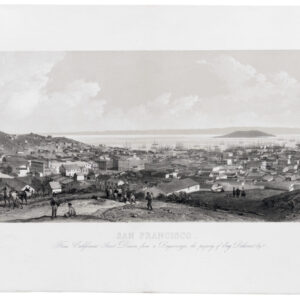Marvelous Gold Rush-era sea chart from the Golden Gate to San Pablo Bay.
Chart of the Bay of San Pablo Straits of Carquines and part of the Bay of San Francisco California
Out of stock
Description
This sea chart represents an important encapsulation of the Bay Area at a time of momentous change.
The explosion of population caused by Gold Fever led to a demand for more accurate maritime charts of San Francisco Bay. This chart offers excellent detail around the Golden Gate and bay coast of Marin County, as well as depth sounds and triangulation work within San Pablo Bay.
In addition, city grids are depicted for San Francisco, Vallejo, and Benicia, the three most important cities in the area at this time, as well as smaller settlements at places like San Rafael, San Antonio (Oakland), and San Leandro. One can see the tripartite division of San Francisco: the city, Mission Dolores, and the presidio.
An essential item for collector’s of Californiana.
Cartographer(s):
Cadwalader Ringgold (August 20, 1802 – April 29, 1867) was an officer in the United States Navy who served in the United States Exploring Expedition, later headed an expedition to the Pacific Northwest and, after initially retiring, returned to service during the Civil War. During 1838–42, he was third in command of the United States Exploring Expedition in the Pacific, commanding Porpoise from 1840 at the invitation of the head of the project, Charles Wilkes. He carried out surveys of Antarctica, the South American coast, the Tuamotu Islands, Tonga, New Zealand and the Northwest Pacific coast of North America.
Ringgold was promoted to commander on July 16, 1849 and began the definitive survey of the San Francisco Bay region, suddenly important because of the discovery of gold in the area. Ringgold both built on previous surveys, most notably Frederick Beechey’s 1833 chart, and undertook a new series of triangulation and azimuth efforts, beginning at modern-day Pittsburgh, CA (then known as the ‘New York of the Pacific’). After the California surveys, Ringgold helped Navy officials choose a location for a dockyard for the Navy’s Pacific station. It later became the Mare Island Navy Yard.
In 1851, Ringgold published a series of charts, views, and sailing directions for the entrance to San Francisco Bay and the inland waterways of gold rush California. The charts paint an important picture of the region during a time of tremendous change.
Condition Description
Expertly laid on archival paper; left margin completed.
References
Woodbridge, p. 42-4; Cowan p.533; Howes R303; Kurutz 536e; Streeter 2679 (1st ed).



![PORT OF SAN FRANCISCO. WHERE THE FAR EAST BEGINS [Japanese language version]](https://neatlinemaps.com/wp-content/uploads/2021/01/NL-00879_Thumbnail-300x300.jpg)
![PORT OF SAN FRANCISCO. WHERE THE FAR EAST BEGINS [Japanese language version]](https://neatlinemaps.com/wp-content/uploads/2021/01/NL-00879_Thumbnail.jpg)
![[1906 EARTHQUAKE PANORAMA – FINANCIAL DISTRICT]](https://neatlinemaps.com/wp-content/uploads/2020/10/Screen-Shot-2023-02-06-at-6.55.56-PM-300x300.png)

